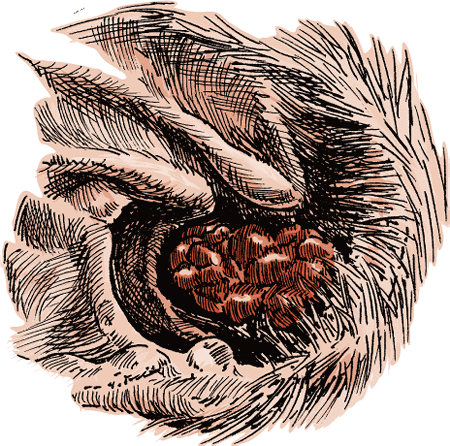Tumors of the Ear Canal in Dogs
- Ear Disorders of Dogs
- Ear Structure and Function in Dogs
- Deafness in Dogs
- Disorders of the Outer Ear in Dogs
- Otitis Externa in Dogs
- Otitis Media and Interna in Dogs
- Tumors of the Ear Canal in Dogs
Also see professional content regarding tumors of the ear canal.
Tumors may develop from any of the structures lining or supporting the ear canal, including the outer layer of skin, the glands that produce earwax and oil, or any of the bones, connective tissues, muscles, or middle layers of the skin. Tumors of the external ear canal and pinna are more common than tumors of the middle or inner ear. Cocker Spaniels are more likely to have ear canal tumors than other breeds of dogs. Middle-aged to older dogs are more likely to have ear canal tumors than younger animals.
Although the exact cause of ear canal tumors is unknown, it is thought that longterm inflammation of the ear canal may lead to an abnormal growth and development of tissue, and finally to the formation of a tumor. Thickening secretions from earwax glands during inflammation of the external ear canal may stimulate the production of cancerous cells. Ear canal tumors are more likely to be benign than malignant. Of those that are malignant, less than 10% spread beyond the local area.
Signs of ear canal tumors include ear discharge (waxy, pus-filled, or bloody) in one ear, a foul odor, head shaking, ear scratching, swelling or draining abscesses near the ear, and deafness. If the middle or inner ear is involved, the dog may have loss of balance and coordination, head tilt, and other neurologic signs. In any case of inflammation in one ear that does not respond to treatment, a tumor of the ear canal should be suspected by your veterinarian.
Earwax Gland Tumors
Benign or malignant tumors that develop from the earwax glands in the external ear canal occur occasionally in middle-aged or older dogs. Malignant earwax tumors are more common than benign ones. Animals with a history of longterm inflammation of the ear are more likely to develop earwax gland tumors, and Cocker Spaniels are particularly susceptible. These tumors appear as firm, dome-shaped, pinkish white shapes, often with stalk-shaped lumps or flattened patches that may have slow-healing sores. Because many tumors completely obstruct the ear canal, they are often associated with inflammation of the external or middle ear accompanied by a pus-filled to bloody discharge. Loss of balance may be present if there is middle ear involvement. Malignant earwax tumors can spread to regional lymph nodes and to salivary glands, so your veterinarian may recommend that they be removed.
Surgical removal of benign ear canal tumors is possible in many cases. Laser surgery has also been used. More extensive surgery is required for malignant ear canal tumors. Average survival time of animals with malignant ear canal tumors has been reported to be almost 5 years in dogs; however, dogs with extensive tumor involvement had a less favorable outlook. Radiation therapy can be used to treat incompletely removed malignant earwax gland tumors, with a 56% 1-year survival rate reported.
Your veterinarian can discuss your pet’s individual health status and provide you with a more complete outlook for the possible result of any surgery or other treatment.
For More Information
Also see professional content regarding tumors of the ear canal.
Resources In This Article
- Ear Disorders of Dogs
- Ear Structure and Function in Dogs
- Deafness in Dogs
- Disorders of the Outer Ear in Dogs
- Otitis Externa in Dogs
- Otitis Media and Interna in Dogs
- Tumors of the Ear Canal in Dogs






